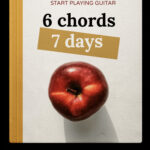The guitar capo stands out as an essential and remarkably versatile tool in any guitarist’s collection. This simple device, clamping onto your guitar neck at a chosen fret, fundamentally alters your instrument’s pitch. Derived from the Italian term capotasto, meaning “head of the fretboard,” a capo’s primary function is to elevate the strings’ pitch by effectively shortening their vibrating length. This ingenious action allows guitarists to transpose songs into higher keys while maintaining their familiar chord shapes and fingerings. For those looking to explore this invaluable accessory, Guitar Center offers a wide selection to suit every need and guitar type.
One of the most enlightening applications of a guitar capo is its ability to unlock new perspectives on familiar songs. By placing a capo at a different fret, you can play in the original key of a song, but in a completely different position on the guitar neck. Consider a song in E major. By positioning a capo at the 7th fret, you could then use an A chord shape to voice the E major chord. This principle extends across the entire song; every chord, riff, and fill is transposed, requiring you to adapt your playing around the new capo position. This exercise is incredibly beneficial for deepening your fretboard knowledge and discovering alternative voicings and fingerings. While some might dismiss the capo as a shortcut, experienced guitarists understand it’s simply another tool in the arsenal, no different from a pick or a slide. Many legendary musicians, including Pete Townshend, Bob Dylan, George Harrison (famously on “Here Comes the Sun”), and Keith Richards, alongside countless blues and folk pioneers, have harnessed the capo’s potential to enrich their music. You can find inspiration from these greats and explore your own capo journey with the variety available at Guitar Center.
Choosing the right guitar capo is crucial for optimal performance and depends largely on your guitar. The key differentiator is the fretboard radius – whether it’s flat, like those found on nylon-string classical guitars and some steel-string acoustics, or curved, common on most steel-string acoustics and electric guitars. The most basic capo design features a rubber-coated bar for string clamping and a rubber or elastic strap that secures it around the neck. These are budget-friendly and compact but typically require two hands for adjustments. For players who frequently change capo position during performances or practice, spring-loaded clamp capos, such as the popular Dunlop Trigger models available at Guitar Center, are a game-changer. These allow for swift, one-handed operation, making transitions seamless.
Beyond these, there are designs that employ an adjustable screw to fine-tune the clamping pressure, ensuring buzz-free performance without excessive force. Roller-based capos also offer quick key changes, ideal for dynamic playing situations. For specialized needs, partial capos like the Kyser Short Cut 3-String capo or the Third Hand partial capo open up unique sonic territories. The Third Hand capo, with its individually adjustable rubber pieces, lets you capo specific strings while leaving others open. Imagine strumming an open E minor or A chord shape while the higher strings ring freely – this unlocks unconventional chord voicings and textures, without needing to relearn scales in altered tunings. While electronic transposition tools like the Digitech Whammy or Morpheus Capo pedal exist, these are considerably more expensive and lack the tactile exploration of the fretboard that a physical capo provides. Guitar Center’s knowledgeable staff can guide you through the selection process to find the perfect capo for your musical explorations.
Guitarists with diverse collections of instruments often find themselves owning multiple capos. Your 12-string guitar, for instance, will likely demand a capo with higher tension than your delicate nylon-string classical. Banjo and mandolin players, too, require capos specifically contoured to their instrument necks. If you’re new to the world of guitar capos, now is the perfect time to experiment. Visit your local Guitar Center or explore online to discover the range of capos available and unlock a spectrum of new musical possibilities that this unassuming device can bring to your playing. You might just find your new favorite songwriting tool or performance enhancement.

